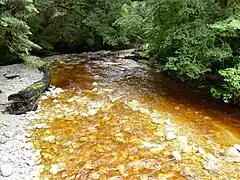Ōpārara River
The Ōpārara River is a river in the West Coast region of New Zealand's South Island. It is best known for the limestone arches it carved in the Oparara Basin.
| Ōpārara River | |
|---|---|
 Ōpārara River near Moria Gate Mirror Tarn | |
| Location | |
| Country | New Zealand |
| Physical characteristics | |
| Mouth | |
• location | Karamea Bight |
• elevation | 0 metres (0 ft) |
| Length | 25 kilometres (16 mi) |
The river and most of its tributaries originate in the Fenian Ranges in the Kahurangi National Park, where the river flows through a section of the Honeycomb Hill Cave. Further downstream it continues through the Ōpārara Arch and the Moria Gate Arch, both of which are popular walking destinations. These sections of the Ōpārara River, while still in dense native forest, can be reached by a forestry road. For the majority of its length it continues to meander south through the Ōpārara Basin before turning west to flow into the Tasman Sea near the small settlement of Ōpārara north of the township of Karamea.
The river's color varies from tea-like shades of golden brown to red from the natural organic tannins released into the water by several of the plant species in the area. Leaves and other plant matter on the forest floor releases these tannins as they decompose – this eventually leeches into and stains the water, with the shade and intensity varying depending on rainfall and season.
The river and contributing streams in the area are a habitat for the endangered South Island whio; the area used to sustain a large population of whio and is now a location for a recovery programme run by the New Zealand Department of Conservation.[1] The rare and protected Ōpārara giant land snail (Powelliphanta annectens) has only been found in areas around 700 m from the Ōpārara River.[2]
Brown trout can be fished year-round in the river's estuary.[3]
- Waters of the Oparara River stained different hues from golden-brown to red by naturally occurring tannins


References
- "Saving whio on the Styx and Oparara Rivers" (PDF). NZ Department of Conservation. Retrieved 17 September 2013.
- "Carnivorous land snails – Powelliphanta" (PDF). NZ Department of Conservation. Archived from the original (PDF) on 21 October 2012. Retrieved 17 September 2013.
- "Oparara River fishing". Archived from the original on 30 September 2018. Retrieved 17 September 2013.